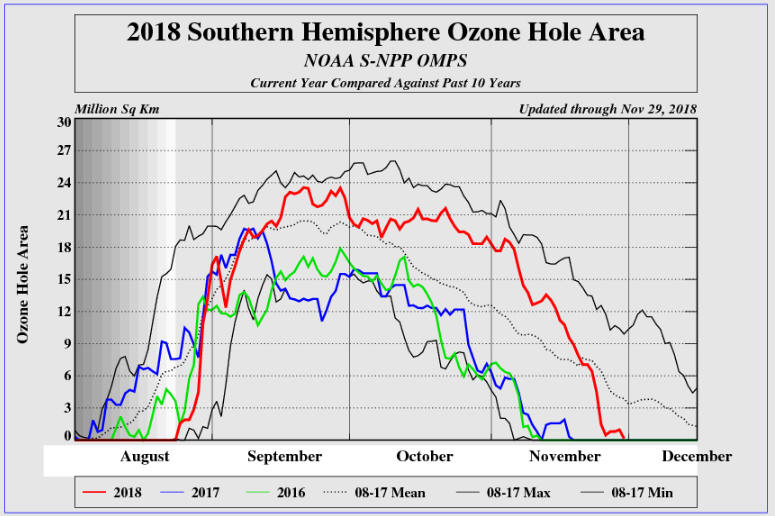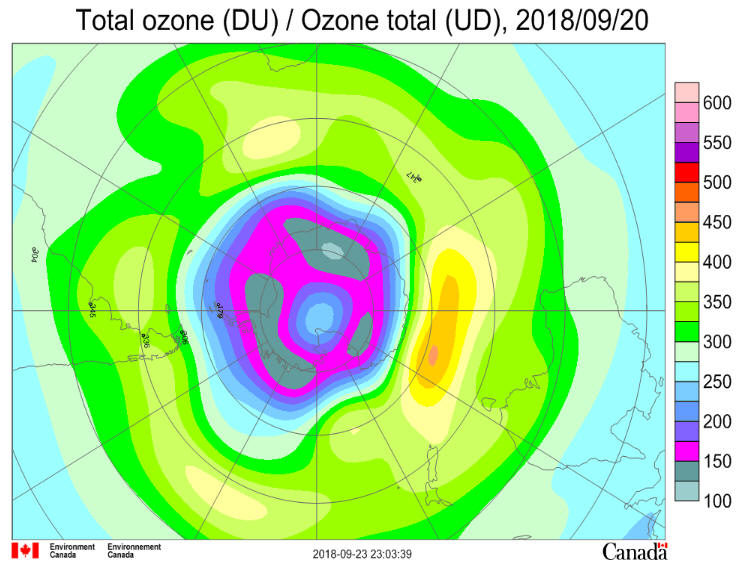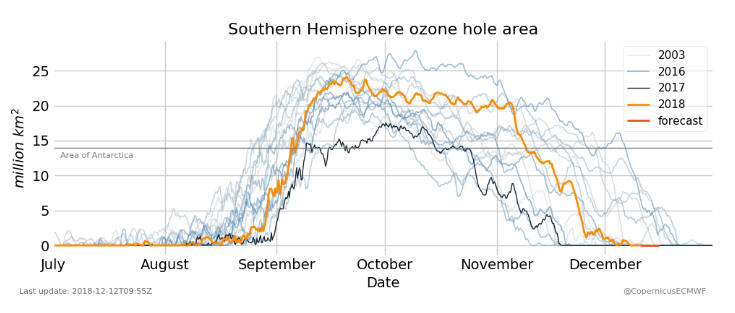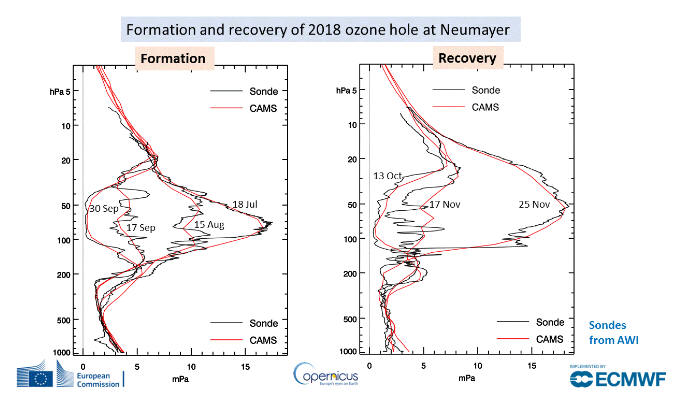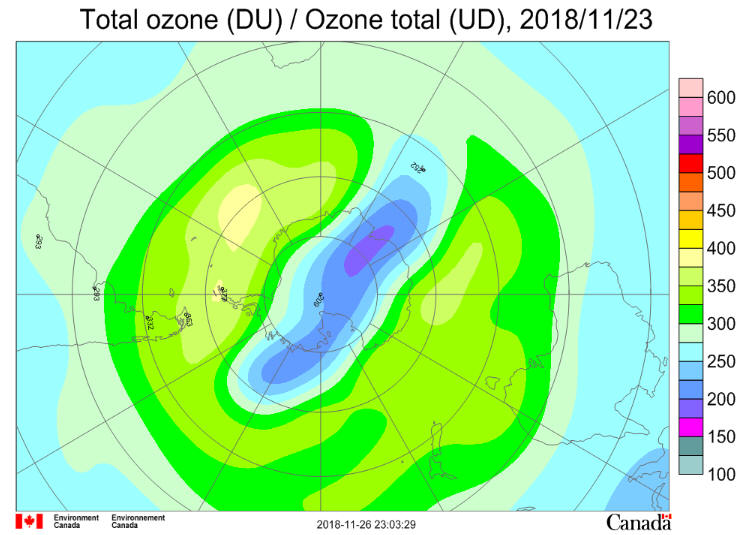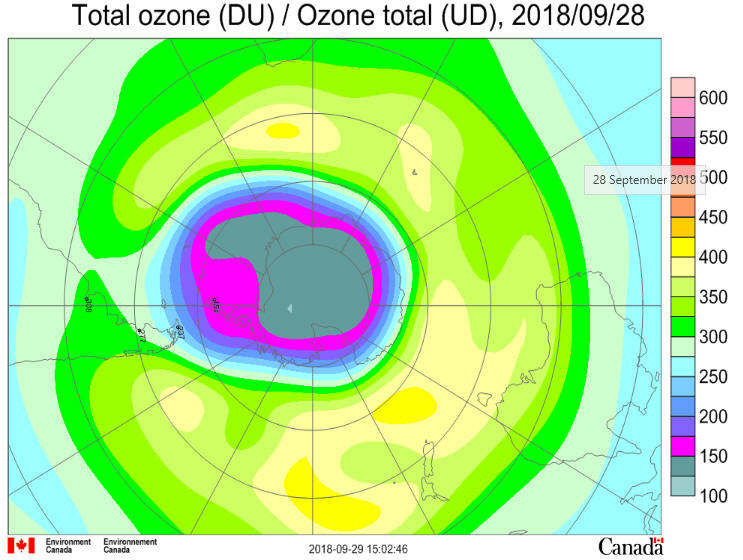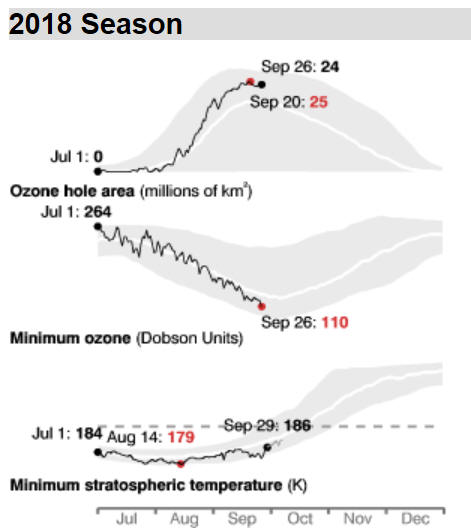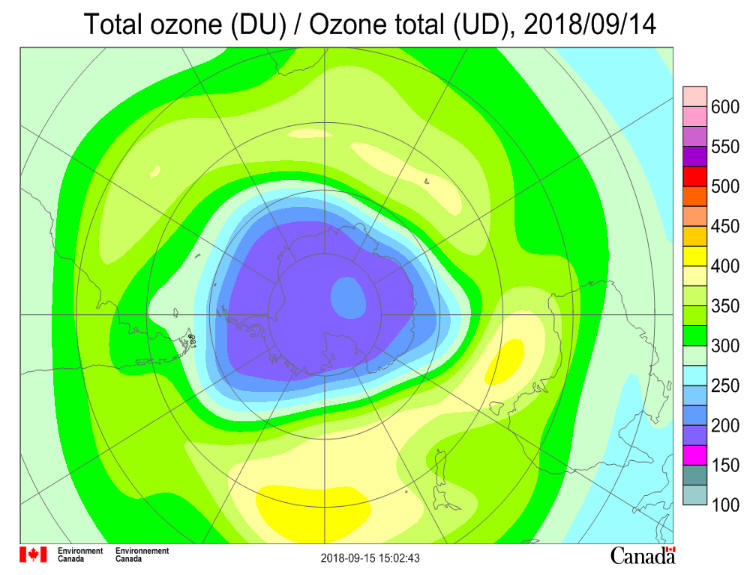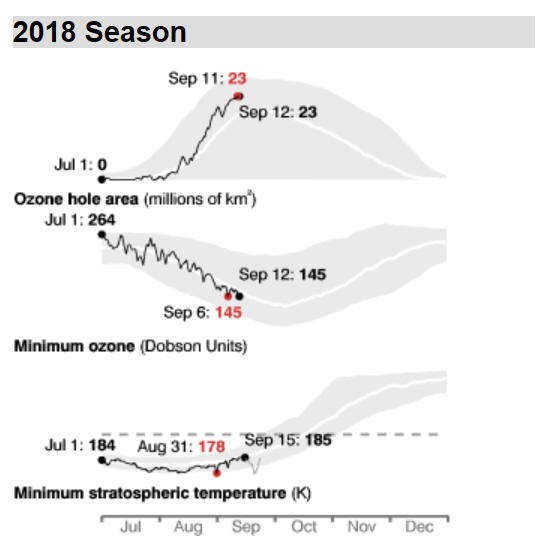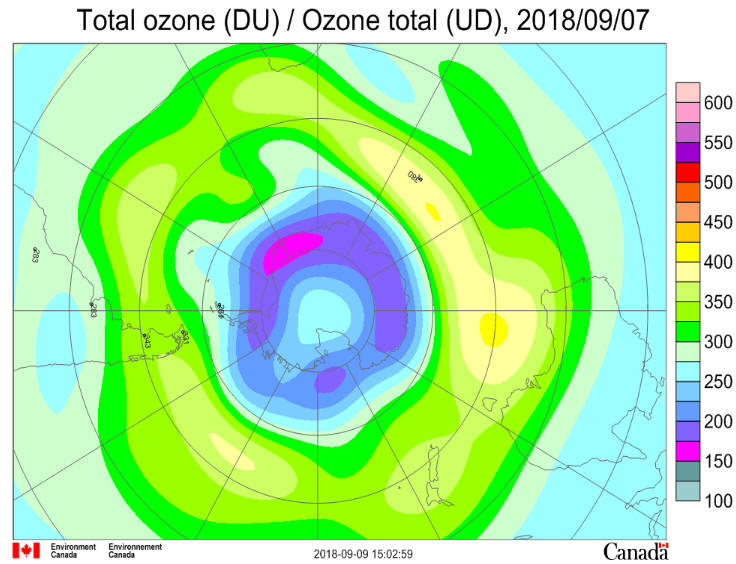|
The Ozone Hole 2018
Climate Prediction Center - Stratosphere: SBUV-2 Total Ozone - Ozone Hole (noaa.gov)
Ozone Hole Modest Despite Optimum Conditions for Ozone Depletion The ozone hole that forms in the upper atmosphere over Antarctica each September was slightly above average size in 2018, NOAA and NASA scientists reported today. Colder-than-average temperatures in the Antarctic stratosphere created ideal conditions for destroying ozone this year, but declining levels of ozone-depleting chemicals prevented the hole from as being as large as it would have been 20 years ago. “Chlorine levels in the Antarctic stratosphere have fallen about 11 percent from the peak year in 2000,” said Paul A. Newman, chief scientist for Earth Sciences at NASA's Goddard Space Flight Center in Greenbelt, Maryland. "This year’s colder temperatures would have given us a much larger ozone hole if chlorine was still at levels we saw back in the year 2000.” According to NASA, the annual ozone hole reached an average area coverage of 8.83 million square miles (22.9 square kilometers) in 2018, almost three times the size of the contiguous United States. It ranks 13th largest out of 40 years of NASA satellite observations. Nations of the world began phasing out the use of ozone-depleting substances in 1987 under an international treaty known as the Montreal Protocol. The 2018 ozone hole was strongly influenced by a stable and cold Antarctic vortex — the stratospheric low pressure system that flows clockwise in the atmosphere above Antarctica. These colder conditions — among the coldest since 1979 — helped support formation of more polar stratospheric clouds, whose cloud particles activate ozone-destroying forms of chlorine and bromine compounds. In 2016 and 2017, warmer temperatures in September limited the formation of polar stratospheric clouds and slowed the ozone hole’s growth. In 2017, the ozone hole reached a size of 7.6 million square miles (19.7 square kilometers) before starting to recover. In 2016, the hole grew to 8 million square miles (20.7 square kilometers). However, the current ozone hole area is still large compared to the 1980s, when the depletion of the ozone layer above Antarctica was first detected. Atmospheric levels of man-made ozone-depleting substances increased up to the year 2000. Since then, they have slowly declined but remain high enough to produce significant ozone loss. NOAA scientists said colder temperatures in 2018 allowed for near-complete elimination of ozone in a deep, 3.1-mile (5-kilometer) layer over the South Pole. This layer is where the active chemical depletion of ozone occurs on polar stratospheric clouds. The amount of ozone over the South Pole reached a minimum of 104 Dobson units on Oct. 12 — making it the 12th lowest year out of 33 years of NOAA ozonesonde measurements at the South Pole, according to NOAA scientist Bryan Johnson. "Even with this year's optimum conditions, ozone loss was less severe in the upper altitude layers, which is what we would expect given the declining chlorine concentrations we’re seeing in the stratosphere," Johnson said. A Dobson unit is the standard measurement for the total amount of ozone in the atmosphere above a point on Earth's surface, and it represents the number of ozone molecules required to create a layer of pure ozone 0.01 millimeters thick at a temperature of 32 degrees Fahrenheit (0 degrees Celsius) at an atmospheric pressure equivalent to Earth’s surface. A value of 104 Dobson units would be a layer that is 1.04 millimeters thick at the surface, less than the thickness of a dime. Prior to the emergence of the Antarctic ozone hole in the 1970s, the average amount of ozone above the South Pole in September and October ranged from 250 to 350 Dobson units. What is ozone and why does it matter? Ozone comprises three oxygen atoms and is highly reactive with other chemicals. In the stratosphere, roughly 7 to 25 miles (about 11 to 40 kilometers) above Earth’s surface, a layer of ozone acts like sunscreen, shielding the planet from ultraviolet radiation that can cause skin cancer and cataracts, suppress immune systems and damage plants. Ozone can also be created by photochemical reactions between the Sun and pollution from vehicle emissions and other sources, forming harmful smog in the lower atmosphere. NASA and NOAA use three complementary instrumental methods to monitor the growth and breakup of the ozone hole each year. Satellite instruments like the Ozone Monitoring Instrument on NASA’s Aura satellite and the Ozone Mapping Profiler Suite on the NASA-NOAA Suomi National Polar-orbiting Partnership satellite measure ozone across large areas from space. The Aura satellite’s Microwave Limb Sounder also measures certain chlorine-containing gases, providing estimates of total chlorine levels. The total amount of ozone in the atmosphere is exceedingly small. All of the ozone in a column of the atmosphere extending from the ground to space would be 300 Dobson units, approximately the thickness of two pennies stacked one on top of the other. NOAA scientists monitor the thickness of the ozone layer and its vertical distribution above the South Pole by regularly releasing weather balloons carrying ozone-measuring “sondes” up to 21 miles (~34 kilometers) in altitude, and with a ground-based instrument called a Dobson spectrophotometer. To learn more about NOAA and NASA efforts to monitor ozone and ozone-depleting gases, visit: https://ozonewatch.gsfc.nasa.gov/ https://www.esrl.noaa.gov/gmd/hats/
Antarctic Situation at 2019 January 28British Antarctic Survey Ozone BulletinAntarctic ozone today: The 2018 ozone hole is over and the southern polar vortex has dissipated. Ozone amounts are broadly uniform across the continent. The lowest ozone values, around 270 DU, are over coastal West Antarctica. Amounts are higher, up to 320 DU, in places over the southern ocean. There are marked differences between the various satellite ozone measurements and analyses. The KNMI analysis and TEMIS forecasts are close to the observed values, whereas the Canadian analysis seems largely based on SMOBA data and is clearly at variance with ground based observations. The summer atmospheric circulation is over the continent. Temperatures in the ozone layer are near their peak and are well above the -78°C Polar Stratospheric Clouds (PSC) formation threshold. Temperatures are highest over Antarctica and decline towards the equator. They are generally not far from the normal. The 2018 ozone hole: The polar vortex began to form in early May and reached its maximum area in late September at around 34 million square kilometres. It was a little larger than the decadal mean in size, and was generally of average or above average stability. PSCs began to form in mid May and the maximum area with potential PSCs was larger than the decadal mean and close to the maximum of the last decade at around 27 million square kilometres. Ozone hole values below 220 DU were reached in late August, later than in the past couple of years; this was largely due to the stability in the stratosphere this year. The ozone hole grew rapidly and by its maximum in late September was above the average size for the decade at 24.8 million square kilometres. The stratosphere became less stable at the end of September, but then returned to stable conditions. The ozone hole shrank when it was unstable, but stopped shrinking with the return to stability. It became much less stable in November, with the vortex oscillating between a very elongated form and a more circular form. This lack of stability in early November lead to a rapid filling of the ozone hole. The area with ozone hole values had declined to zero by the end of November, later than in the last two years, but sooner than the decadal average. The vortex itself lasted until mid December. When the vortex became less stable the ozone hole became more elongated and South Georgia was at the edge of the ozone hole at times during October and November. NASA observations show that a minimum ozone amount of 102 DU was reached on October 11 and 12. Although this is a low value it is not as low as around 1990 to 2000. Ozone depletion would have been much worse this year without the protection of the Montreal Protocol. |
||||||||||
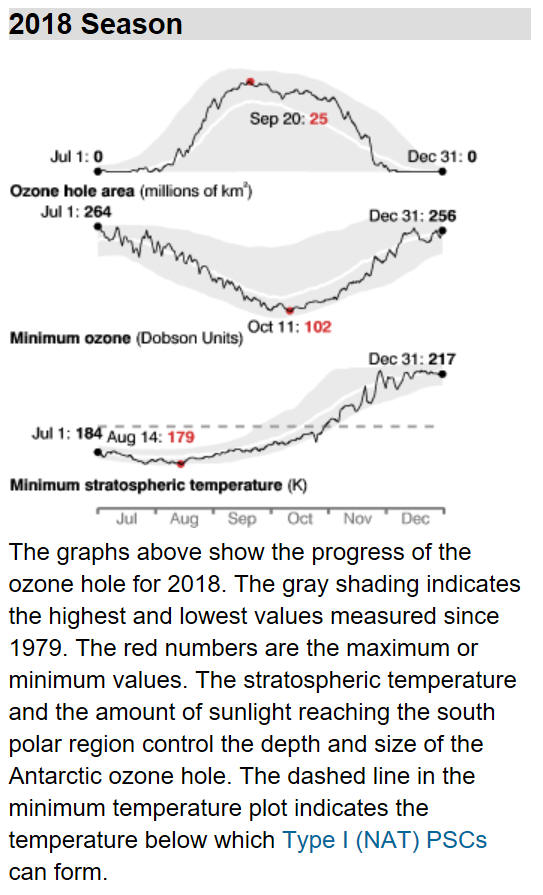 https://ozonewatch.gsfc.nasa.gov |
||||||||||
The 2018 Antarctic Ozone Hole Season Date: 17th December 2018This year’s Antarctic ozone hole has finally come to an end. It was one of the largest holes of recent years. The process that creates the Antarctic ozone hole begins around May, when the stratosphere cools as winter starts. As temperatures drop, polar stratospheric clouds (PSCs) form and a polar vortex develops. The PSCs provide ideal conditions for reactive chlorine compounds to form. Next, spring arrives in the region, bringing sunlight which starts chemical reactions that rapidly destroy ozone. This ozone depletion starts at the edges of the vortex, where the sun reaches first, then continues towards the South Pole as spring progresses. The polar vortex holds the area of depletion as an isolated stable region, creating the instantly recognisable ‘ozone hole’, defined as the area where ozone columns are less than 220 Dobson Units (DU). The Copernicus Atmosphere Monitoring Service (CAMS), implemented by ECMWF on behalf of the European Union, carefully monitors ozone around the world, with data coming from satellites and ozone sondes. The resulting charts show that this year’s Antarctic ozone hole started late, towards the end of August. But the very low temperatures meant that the hole then developed quickly to reach a maximum extent in late September, becoming one of the larger holes of recent years.
|
||||||||||
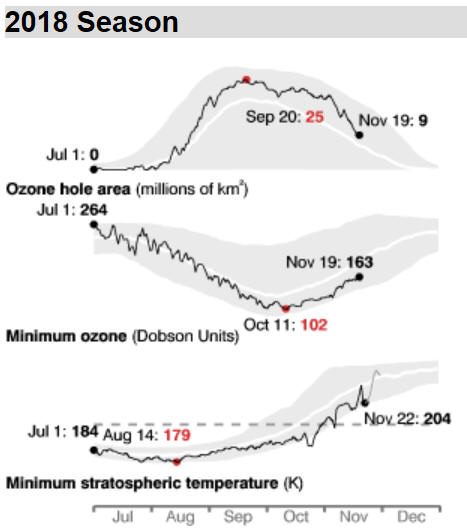 https://ozonewatch.gsfc.nasa.gov |
||||||||||
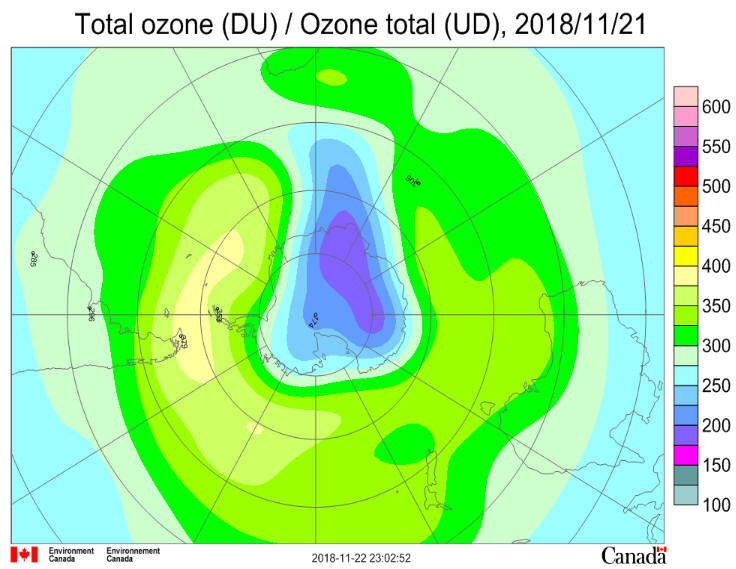 |
||||||||||
Antarctic Situation at 2018 November 12British Antarctic Survey Ozone BulletinAntarctic ozone today: The 2018 ozone hole has passed its maximum extent and ozone values are now on the rise across the continent. The vortex became unstable in early November resulting in it becoming very elongate, before returning to a more circular state. The hole is currently (November 4) well above average size for the decade at 19 million square kilometres, and is much larger than in 2017 or 2016. The lowest ozone values, around 140 DU, are near Dronning Maud Land. Amounts are higher, over 400 DU in places over the southern ocean, particularly in the Pacific sector. Ozone values are still below the ozone hole threshold of 220 DU across much of the continent, but range from around 150 DU to 350 DU, with the highest value along the coastal fringes of the Amundsen and Ross Seas and Enderby Land. There are marked differences between the various satellite ozone measurements and analyses. The KNMI analysis and TEMIS forecasts are close to the observed values, whereas the Canadian analysis seems largely based on SMOBA data and is clearly at variance with ground based observations. The atmospheric circulation over the continent is now starting a spring warming. Temperatures in the ozone layer are rising and are above the -78°C Polar Stratospheric Clouds (PSC) formation threshold, but some clouds will remain. Temperatures are highest in a broad ring around 45°S and decline towards the pole, where they are coldest, and to the equator . They are generally below the normal within the polar vortex. The southern polar vortex has passed its maximum size. The vortex area is still larger than the decadal mean at around 27 million square kilometres near the centre of the ozone layer, but is shrinking. The area that can form PSCs has declined to near zero, but much later than usual over the last decade. The lower stratosphere has become unstable as is usual as the vortex begins to break up. The ozone hole will persist for at least another week. The 2018 ozone hole: The polar vortex began to form in early May and reached its maximum area in late September at around 34 million square kilometres. It was a little larger than the decadal mean in size, and was generally of average or above average stability. PSCs began to form in mid May and the maximum area with potential PSCs was larger than the decadal mean and close to the maximum of the last decade at around 27 million square kilometres. Ozone hole values below 220 DU were reached in late August, later than in the past couple of years; this was largely due to the stability in the stratosphere this year. The ozone hole grew rapidly and by its maximum in late September was above the average size for the decade at 24.8 million square kilometres. The stratosphere became less stable at the end of September, but then returned to stable conditions. The ozone hole shrank when it was unstable, but stopped shrinking with the return to stability. It became much less stable in early November, with the vortex becoming very elongated before returning to a more circular form. Ozone values are rising across the continent, but the ozone hole still covered 19 million square kilometres on November 4. When the vortex became less stable the ozone hole became more elongated and South Georgia was at the edge of the ozone hole at times during October and November. NASA observations show that a minimum ozone amount of 102 DU was reached on October 11 and 12. Although this is a low value it is not as low as around 1990 to 2000. Ozone depletion would have been much worse this year without the protection of the Montreal Protocol. |
||||||||||
|
|
||||||||||
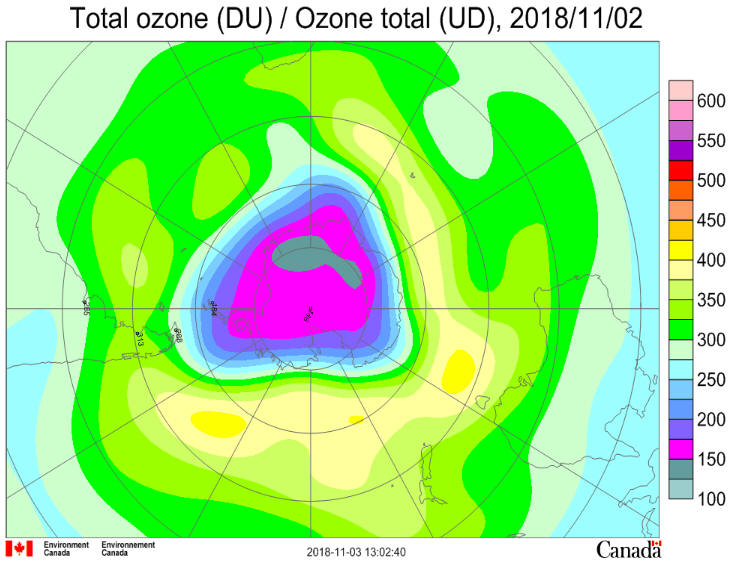 |
||||||||||
Antarctic Situation at 2018 October 29 British Antarctic Survey Ozone BulletinAntarctic ozone today: The 2018 ozone hole has passed its maximum extent and ozone values are slowly beginning to rise across the continent. Conditions have remained relatively stable through October so far and the hole is currently above average size for the decade at 19 million square kilometres, and is much larger than in 2017 or 2016. The lowest ozone values, around 130 DU, are broadly over the Pole. Amounts are higher, over 400 DU in places over the southern ocean, particularly south of Australia. Ozone values are below the ozone hole threshold of 220 DU across much of the continent, but range from around 130 DU to 350 DU, with the highest value along the coastal fringe south of Australia. There are marked differences between the various satellite ozone measurements and analyses. The KNMI analysis and TEMIS forecasts are close to the observed values, whereas the Canadian analysis seems largely based on SMOBA data and is clearly at variance with ground based observations. The southern polar vortex is just past its maximum size. The atmospheric circulation over the continent is slowly beginning the transition to spring. Temperatures in the ozone layer are generally rising but with the temperature still widely below -78°C Polar Stratospheric Clouds (PSC) are extensive in the central part of the ozone layer over the continent. Temperatures are highest in a broad ring around 45°S and decline towards the pole, where they are coldest, and to the equator . They are generally a little below the normal within the polar vortex. The vortex area is larger than the decadal mean at around 32 million square kilometres near the centre of the ozone layer, but is slowly beginning to shrink. The area with PSCs present has passed its largest and is shrinking rapidly; it is now around 5 million square kilometres, still above the average for the decade at this time of year. The lower stratosphere has become a little less stable as is usual as the vortex begins to break up. The vortex is becoming less circular in shape, and the Falklands and South Georgia may be briefly affected by the ozone hole later in the first week of November. The 2018 ozone hole: The polar vortex began to form in early May and reached its maximum area in late September at around 34 million square kilometres. It was a little larger than the decadal mean in size, and was generally of average or above average stability. PSCs began to form in mid May and the maximum area with potential PSCs was larger than the decadal mean and close to the maximum of the last decade at around 27 million square kilometres. Ozone hole values below 220 DU were reached in late August, later than in the past couple of years; this was largely due to the stability in the stratosphere this year. The ozone hole grew rapidly and by its maximum in late September was above the average size for the decade at 23 million square kilometres. The stratosphere became less stable at the end of September, but then returned to stable conditions. The ozone hole shrank when it was unstable, but stopped shrinking with the return to stability. Ozone values are very slowly beginning to rise across the continent, but the ozone hole still covers 19 million square kilometres. When the vortex became less stable the ozone hole became more elongated and South Georgia was at the edge of the ozone hole at times during October. |
||||||||||
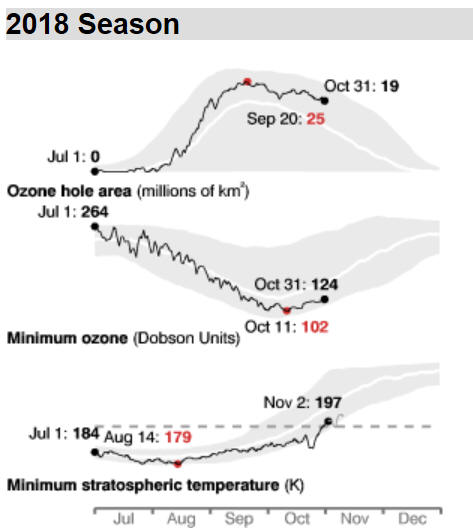 https://ozonewatch.gsfc.nasa.gov |
||||||||||
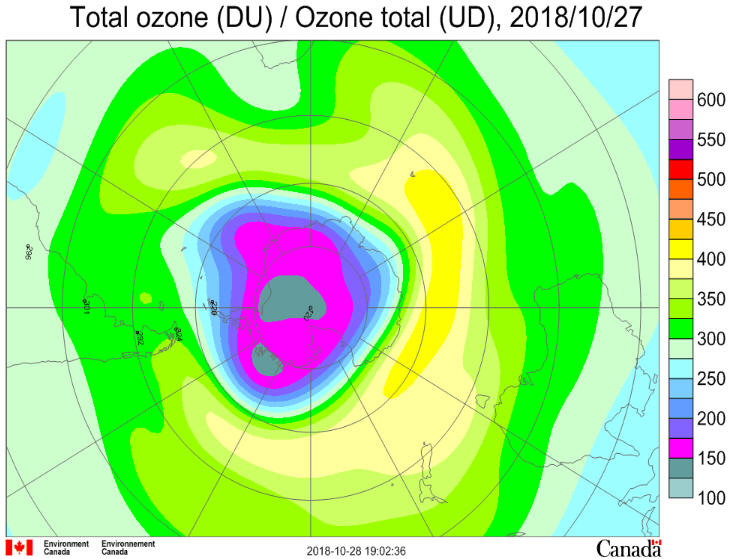 |
||||||||||
Antarctic Situation at 2018 October 26British Antarctic Survey Ozone BulletinAntarctic ozone today: The 2018 ozone hole has passed its maximum extent and ozone values are slowly beginning to rise across the continent. Conditions have remained stable through October so far and the hole is currently above average size for the decade at 20 million square kilometres, and is much larger than in 2017 or 2016. The lowest ozone values, around 130 DU, are between the Antarctic Peninsula and the Pole. Amounts are higher, over 400 DU in places over the southern ocean, particularly south of Australia. Ozone values are below the ozone hole threshold of 220 DU across much of the continent, but range from around 130 DU to 350 DU, with the highest value along the coastal fringe south of Australia. There are marked differences between the various satellite ozone measurements and analyses. The KNMI analysis and TEMIS forecasts are close to the observed values, whereas the Canadian analysis seems largely based on SMOBA data and is clearly at variance with ground based observations. The southern polar vortex is just past its maximum size. The atmospheric circulation over the continent is slowly beginning the transition to spring. Temperatures in the ozone layer are generally rising but with the temperature still widely below -78°C Polar Stratospheric Clouds (PSC) are extensive in the central part of the ozone layer over the continent. Temperatures are highest in a broad ring around 45°S and decline towards the pole, where they are coldest, and to the equator . They are generally a little below the normal within the polar vortex. The vortex area is larger than the decadal mean at around 32 million square kilometres near the centre of the ozone layer, but is slowly beginning to shrink. The area with PSCs present has passed its largest and is beginning to shrink rapidly; it is now around 8 million square kilometres, above the average for the decade at this time of year. The lower stratosphere has returned to more stable conditions and the rise in temperature within the central portion has stalled. The vortex is becoming less circular in shape, and the Falklands and South Georgia may be affected by the ozone hole later in the first week of November. The 2018 ozone hole: The polar vortex began to form in early May and reached its maximum area in late September at around 34 million square kilometres. It was a little larger than the decadal mean in size, and was generally of average or above average stability. PSCs began to form in mid May and the maximum area with potential PSCs was larger than the decadal mean and close to the maximum of the last decade at around 27 million square kilometres. Ozone hole values below 220 DU were reached in late August, later than in the past couple of years; this was largely due to the stability in the stratosphere this year. The ozone hole grew rapidly and by its maximum in late September was above the average size for the decade at 23 million square kilometres. The stratosphere became less stable at the end of September, but then returned to stable conditions. The ozone hole shrank when it was unstable, but stopped shrinking with the return to stability. Ozone values are very slowly beginning to rise across the continent, but the ozone hole still covers 20 million square kilometres. When the vortex became less stable the ozone hole became more elongated and South Georgia was at the edge of the ozone hole at times during October. Antarctic Situation at 2018 October 19 British Antarctic Survey Ozone BulletinAntarctic ozone today: The 2018 ozone hole has passed its maximum extent and ozone values are slowly beginning to rise across the continent. Conditions have remained stable in the first half of October and the hole is currently above average size for the decade at 21 million square kilometres, and is much larger than in 2017 or 2016. The lowest ozone values, below 120 DU, are near the Pole. Amounts are higher, over 400 DU in places over the southern ocean, particularly in the Pacific sector. Ozone values are below the ozone hole threshold of 220 DU across most of the continent, but range from around 120 DU to 300 DU. There are marked differences between the various satellite ozone measurements and analyses. The KNMI analysis and TEMIS forecasts are close to the observed values, whereas the Canadian analysis seems largely based on SMOBA data and is clearly at variance with ground based observations. The southern polar vortex is just past its maximum size. The atmospheric circulation over the continent is slowly beginning the transition to spring. Temperatures in the ozone layer are generally rising but with the temperature widely below -78°C Polar Stratospheric Clouds (PSC) are extensive in the central part of the ozone layer over the continent. Temperatures are highest in a broad ring around 45°S and decline towards the pole, where they are coldest, and to the equator . They are generally a little below the normal within the polar vortex. The vortex area is larger than the decadal mean at around 33 million square kilometres near the centre of the ozone layer, but is beginning to shrink. The area with PSCs present has passed its largest and is beginning to shrink rapidly; it is now around 10 million square kilometres, a bit above the average for the decade at this time of year. The lower stratosphere has returned to more stable conditions and the rise in temperature has stalled. The vortex remains roughly circular in shape, however South Georgia is likely to remain on or near the edge of the ozone hole until at least October 26. |
||||||||||
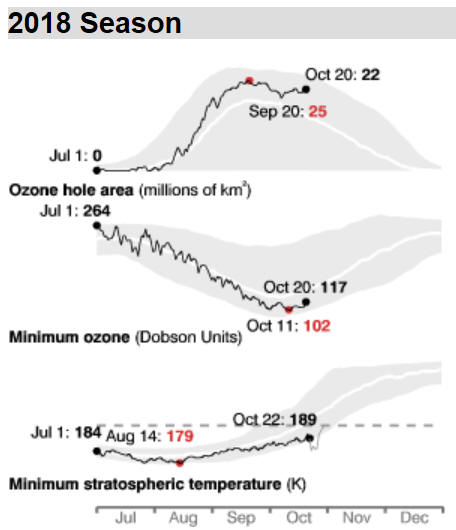 |
||||||||||
Antarctic Situation at 2018 October 8 British Antarctic Survey Ozone BulletinAntarctic ozone today: The 2018 ozone hole has passed its maximum extent and ozone values are beginning to rise across the continent. The hole is currently close to average size for the decade at 20 million square kilometres, and is larger than in 2017 or 2016. The lowest ozone values, about 120 DU, are over Halley. Amounts are higher, over 400 DU in places over the southern ocean, particularly in the Pacific sector. Ozone values are below the ozone hole threshold of 220 DU across most of the continent, but range from around 120 DU to 350 DU. There are marked differences between the various satellite ozone measurements and analyses. The KNMI analysis and TEMIS forecasts are close to the observed values, whereas the Canadian analysis seems largely based on SMOBA data and is clearly at variance with ground based observations. The southern polar vortex is just past its maximum size. The atmospheric circulation over the continent is beginning the transition to spring. Temperatures in the ozone layer are generally rising but with the temperature widely below -78°C Polar Stratospheric Clouds (PSC) are extensive in the central part of the ozone layer over the continent. Temperatures are highest in a broad ring around 45°S and decline towards the pole, where they are coldest, and to the equator . They are generally a little below the normal within the polar vortex. The vortex area is a little larger than the decadal mean at around 33 million square kilometres near the centre of the ozone layer, but is beginning to shrink. The area with PSCs present has passed its largest and is beginning to shrink rapidly; it is now around 12 million square kilometres, close to the average for the decade at this time of year. The lower stratosphere has become much less stable and this is driving the rise in temperature, however for the moment the vortex remains roughly circular in shape. South Georgia may be affected by the ozone hole from October 11 to 13. The 2018 ozone hole: The polar vortex began to form in early May and reached its maximum area in late September at around 34 million square kilometres. It was a little larger than the decadal mean in size, and was generally of average or above average stability. PSCs began to form in mid May and the maximum area with potential PSCs was larger than the decadal mean and close to the maximum of the last decade at around 27 million square kilometres. Ozone hole values below 220 DU were reached in late August, later than in the past couple of years; this was largely due to the stability in the stratosphere this year. The ozone hole grew rapidly and by its maximum in late September was above the average size for the decade at 23 million square kilometres. Ozone values are beginning to rise across the continent, but the ozone hole still covers 20 million square kilometres. |
||||||||||
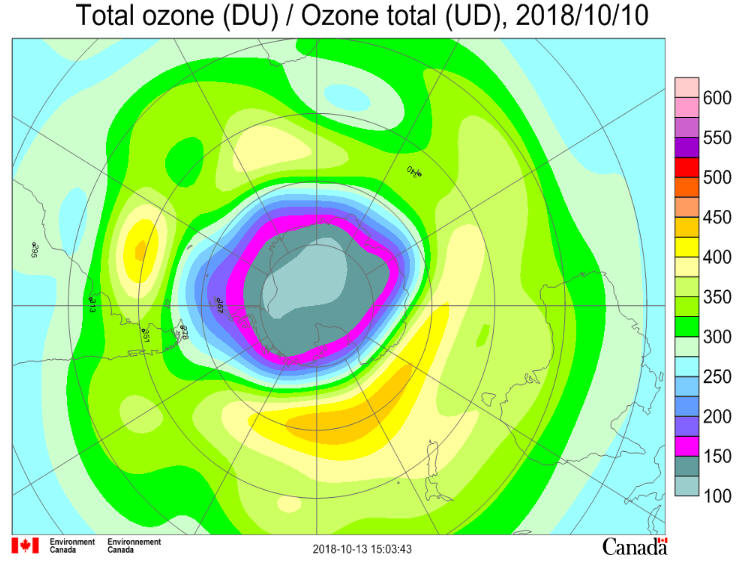 |
||||||||||
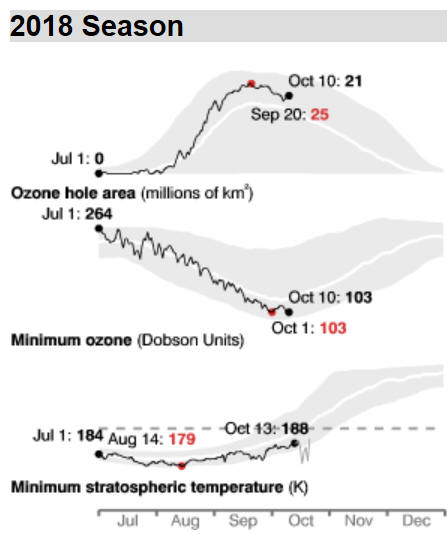 https://ozonewatch.gsfc.nasa.gov |
||||||||||
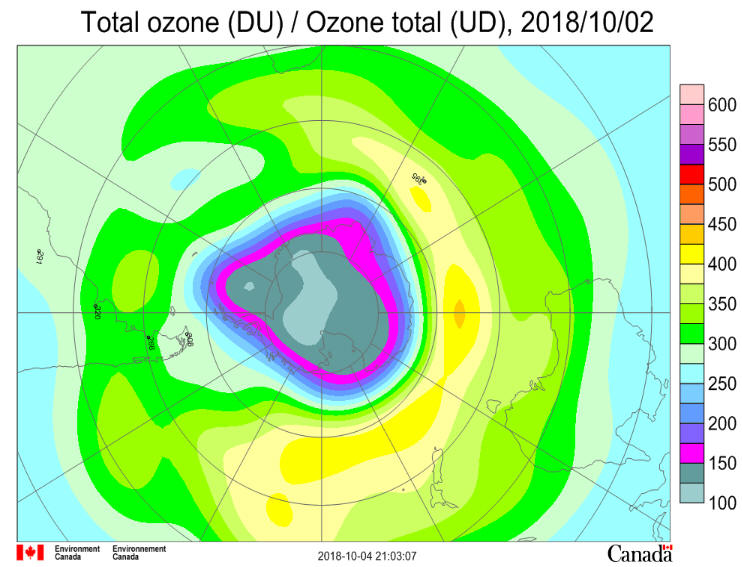 |
||||||||||
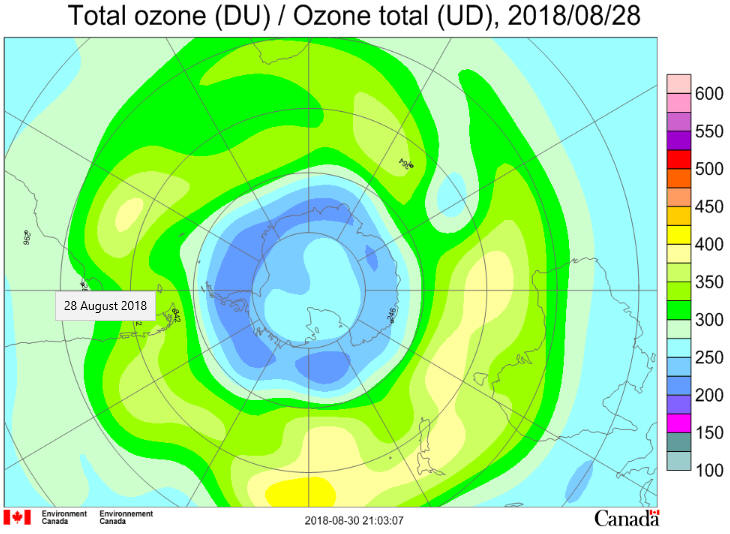
|

